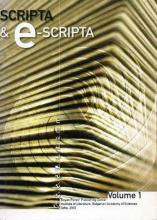Anissava Miltenova
David Birnbaum
Scripta & e-Scripta - The Journal of Interdisciplinary Medieval Studies
-
Summary/Abstract
Aim and Scope; Regularity; Journal Contents; Editorial Board
Subject: Review
